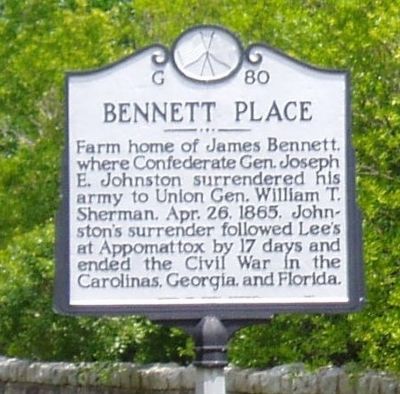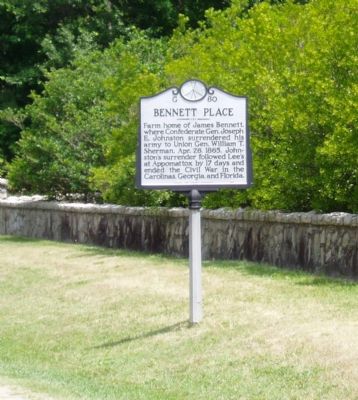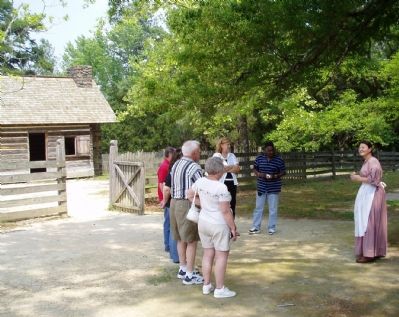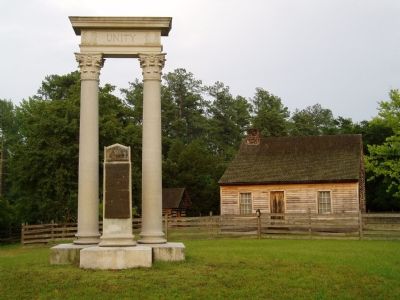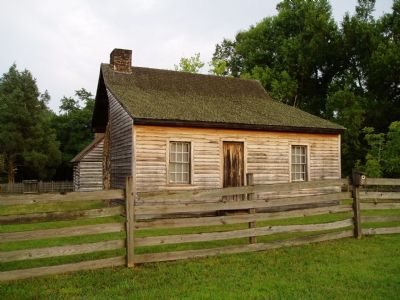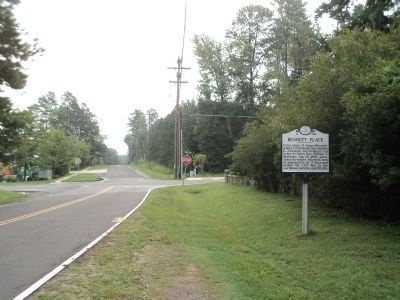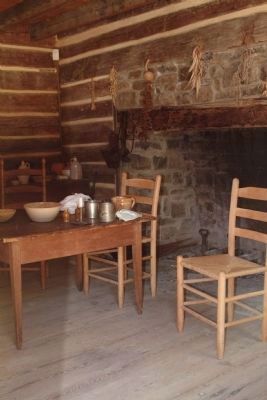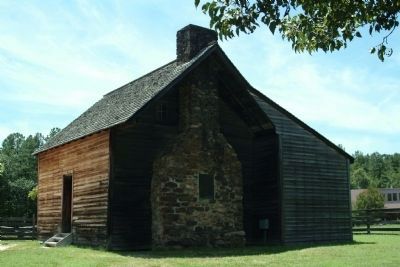Bennett Place in Durham in Durham County, North Carolina — The American South (South Atlantic)
Bennett Place
Erected 1962 by Department of Archives and History. (Marker Number G-80.)
Topics and series. This historical marker is listed in these topic lists: Military • War, US Civil. In addition, it is included in the North Carolina Division of Archives and History series list. A significant historical date for this entry is April 26, 1894.
Location. 36° 1.753′ N, 78° 58.433′ W. Marker is in Durham, North Carolina, in Durham County. It is in Bennett Place. Marker is at the intersection of Bennett Memorial Road and Neal Road, on the right when traveling south on Bennett Memorial Road. Touch for map. Marker is at or near this postal address: 4409 Bennett Memorial Road, Durham NC 27705, United States of America. Touch for directions.
Other nearby markers. At least 8 other markers are within 3 miles of this marker, measured as the crow flies. The Original Chimney of the Bennett House (a few steps from this marker); a different marker also named Bennett Place (within shouting distance of this marker); Unity (within shouting distance of this marker); Rotary Bandstand (within shouting distance of this marker); Meeting of the Generals (within shouting distance of this marker); Dorothy Kitchen: Durham Musician and Educator Extraordinaire (approx. 2.7 miles away); North Carolina (approx. 3 miles away); Duke Homestead (approx. 3 miles away). Touch for a list and map of all markers in Durham.
More about this marker. Bennett Place was one of the surrender sites of the American Civil War.
Regarding Bennett Place. Bennett Place is a designated state historic site. The main house, kitchen house, and smokehouse have been reconstructed. A visitor center provides a museum gallery, reference library, and interpretive movie of the events around the surrender. Living history events occur throughout the year.
Also see . . . Bennett Place State Historic Site. (Submitted on July 1, 2007, by John Walker Guss of Hillsborough, North Carolina.)
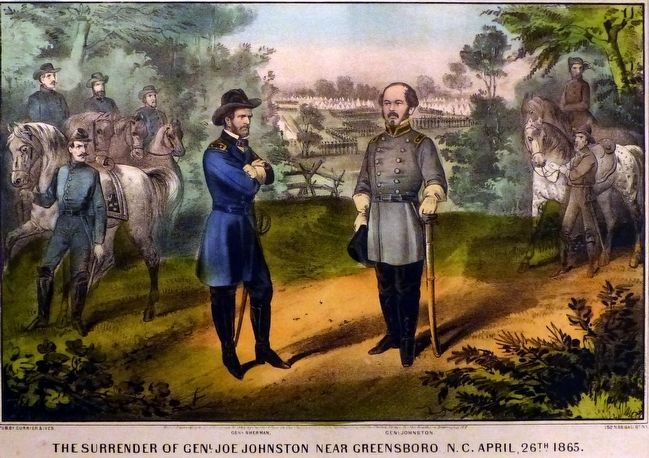
Photographed By Allen C. Browne, February 16, 2015
7. The Surrender of Genl. Joe Johnston near Greensboro, N.C. April 26th, 1865
This 1865 Currier & Ives lithograph of Johnston's Surrender hangs in the National Portrait Gallery in Washington, DC.
“After Lee surrendered at Appomattox, Confederate General Joseph E. Johnston considered the war to be a lost cause and sought terms of peace with his nemesis-in-blue, General William T. Sherman. This print celebrates the formal surrender of Johnston's army on April 26, 1865, near Greensboro, North Carolina.
After the war, Johnston and Sherman, both West Pointers, became friends. In February 1891, Johnston served as a pallbearer at Sherman's funeral in New York City, where he caught a cold and died of complications from pneumonia the next month.” — National Portrait Gallery
“After Lee surrendered at Appomattox, Confederate General Joseph E. Johnston considered the war to be a lost cause and sought terms of peace with his nemesis-in-blue, General William T. Sherman. This print celebrates the formal surrender of Johnston's army on April 26, 1865, near Greensboro, North Carolina.
After the war, Johnston and Sherman, both West Pointers, became friends. In February 1891, Johnston served as a pallbearer at Sherman's funeral in New York City, where he caught a cold and died of complications from pneumonia the next month.” — National Portrait Gallery
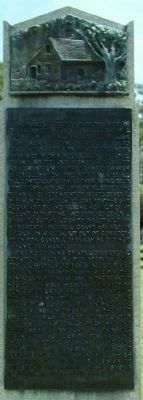
Photographed By Paul Jordan, July 2, 2010
9. Bennett Place Marker
One hundred feet east of this spot in the Bennett house General Joseph E. Johnston and Major General William T. Sherman met at noon April 17, 1865 to discuss terms of a proposed surrender. They met in this house again on April 18 and wrote and signed a "basis of agreement" under the terms of which General Johnston agreed to surrender all the Confederate armies then in the field. President Andrew Johnson rejected the terms agreed upon, sent orders to General Sherman on April 24 to give forty-eight hours notice and resume hostilities at the end of that time and ordered General Grant to go to Raleigh to "direct military movements." General Grant arrived in Raleigh on April 24, but out of consideration for General Sherman he did not assume command.
On the evening of April 25, General Johnston "asked another interview" with General Sherman "to renew negotiations," and on the twenty-sixth at 2 p.m. the generals met a third time in the Bennett house and signed the terms of a military convention, "under which 36,817 Confederate soldiers in North Carolina and 52,453 in Georgia and Florida laid down their arms.
This monument thus marks the spot where the military force of the United States of America finally triumphed and established as inviolate the principle of an indissoluble union. It marks also the spot of the last stand of the Confederacy in maintaining its ideal of indestructible states - an ideal which preserved to the American Union by virtue of the heroic fight grows in strength from year to year.
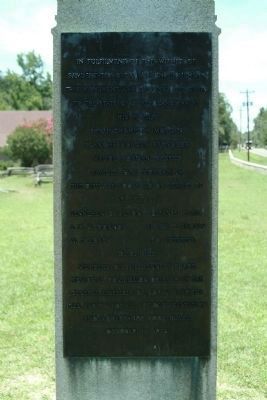
Photographed By Paul Jordan, July 2, 2010
10. The Back Side of the Bennett Place Marker
In fulfilment of the wishes of Samuel Tate Morgan and in his memory this monument and grounds are given to the State of North Carolina by his family.
Sarah Thompson Morgan
Blanche Morgan Reynolds
Maude Morgan Cabell
Samuel Tate Morgan, Jr.
The gift was accepted on behalf of the state by
Bennehan Cameron, Julian S. Carr,
R.D.W. Connor, Frank C. Brown
W.T. Bost, R.O. Everett,
D.H. Hill
Members of the Bennett Place
Memorial Commission created by the
General Assembly of North Carolina
1923, and the formal act of presentation
and acceptance took place
October 12, 1923
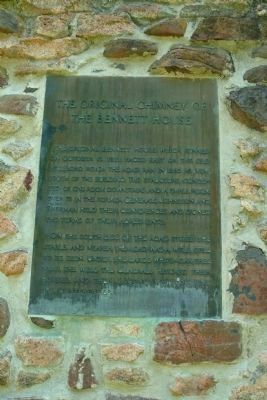
Photographed By Paul Jordan, July 2, 2010
11. The Original Chimney of the Bennett House Marker
The orginal Bennett House, which burned on October 12, 1921, faced east on the old Hillsboro Road: the road ran in 1865 as now south of the building. The structure consisted of one room downstairs and a small room over it: in the former General Johnston and Sherman held their conferences and signed the terms of their agreements.
On the south side of the road stood the stable, and nearer the road was a well, still to be seen. Under the large white-oak tree near the well the Generals hitched their horses, and their escorts waited during the conferences.
Credits. This page was last revised on February 16, 2023. It was originally submitted on July 1, 2007. This page has been viewed 3,290 times since then and 50 times this year. Last updated on November 15, 2020, by Bradley Owen of Morgantown, West Virginia. Photos: 1, 2, 3, 4, 5. submitted on July 1, 2007, by John Walker Guss of Hillsborough, North Carolina. 6. submitted on August 11, 2012, by Bill Coughlin of Woodland Park, New Jersey. 7. submitted on August 30, 2015, by Allen C. Browne of Silver Spring, Maryland. 8, 9, 10, 11, 12. submitted on July 2, 2010, by Paul Jordan of Burlington, N. C., U. S. A.. • J. Makali Bruton was the editor who published this page.
